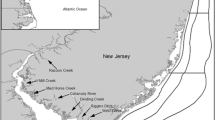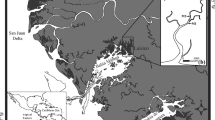Abstract
Chesapeake Bay is the largest estuary in the USA and comprises vast areas of polyhaline to freshwater, tidal fish habitat. The Bay experiences large temperature differences between winter and summer, which in combination with the variety of salinities enables approximately 240 species of fish to be temporary inhabitants. This dynamic environment leads to an ever-changing prey field for predators. The goal of this study was to characterize the diet of one of the few resident, euryhaline predators within the tidal rivers in Virginia, Lepisosteus osseus (longnose gar). The top five prey species were Morone americana, Brevoortia tyrannus, Fundulus spp., Micropogonias undulatus, and Leiostomous xanthurus. The diet composition varied with the seasonal fish assemblages, length of L. osseus, water temperature, and salinity. L. osseus consumed a greater amount of marine and anadromous fishes (%W = 59.4 % and %N = 56.5 %) than resident fishes (%W = 40.6 % and %N = 43.5 %). The seasonal influx of anadromous or coastal spawning fishes appears to be an important prey source for L. osseus and most likely other piscivores in the tributaries of Chesapeake Bay.








Similar content being viewed by others
References
Able, K.W. 2005. A re-examination of fish estuarine dependence: evidence for connectivity between estuarine and ocean habitats. Estuarine, Coastal, and Shelf Science 64: 5–17. doi: 10.1016/j.ecss.2005.02.00 doi:10.1016/j.ecss.2005.02.002 2
Beck, M.W., K.L. Heck, K.W. Able, D.L. Childers, D.B. Eggleston, B.M. Gillanders, B. Halpern, C.G. Hays, K. Hoshino, T.J. Minello, R.J. Orth, P.F. Sheridan, and M.P. Weinstein. 2001. The identification, conservation and management of estuarine and marine nurseries for fish and invertebrates. Bioscience 51: 633–641. doi:10.1641/00063568(2001)051[0633:TICAMO]2.0.CO;2.
Bilkovic, D.M., J.E. Olney, and C.H. Hershner. 2002. Spawning of American shad (Alosa sapidissima) and striped bass (Morone saxatilis) in the Mattaponi and Pamunkey Rivers, Virginia. Fishery Bulletin 100: 632–640.
Buchheister, A., and R.J. Latour. 2011. Trophic ecology of summer flounder in lower Chesapeake Bay inferred from stomach content and stable isotope analyses. Transactions of the American Fisheries Society 140: 1240–1254. doi:10.1080/00028487.2011.618364.
Chipps, S.R., and J.E. Garvey. 2007. Assessment of diet and feeding patterns. In Analysis and interpretation of freshwater fisheries data, ed. C.S. Guy and M.L. Brown, 473–514. Bethesda, MD: American Fisheries Society.
Cowan Jr., J.H., and R.S. Birdsong. 1985. Seasonal occurrence of larval and juvenile fishes in a Virginia Atlantic coast estuary with emphasis on drums (family Sciaenidae). Estuaries 8: 48–59.
Craig, J.F. 1977. The body composition of adult perch, Perca fluvitilis in Windermere, with reference to seasonal changes and reproduction. Journal of Animal Ecology 46: 617–632.
Crumpton, J. 1970. Food habits of longnose gar (Lepisosteus osseus) and Florida gar (Lepisosteus platyrhincus) collected from five central Florida lakes. Proceedings of the Annual Conference, Southeastern Association of Game and Fish Commission 24: 419–424.
Cunjak, R.A. 1988. Physiological consequences of over-wintering in streams: the cost of acclimatization. Canadian Journal of Fisheries and Aquatic Sciences 45: 443–452.
Echelle, A.A., and C.D. Riggs. 1972. Aspects of the early life history of gars (Lepisosteus) in Lake Texoma. Transactions of the American Fisheries Society 101: 106–112.
Ferrara, A.M., and E.R. Irwin. 2001. A Standardized procedure for internal sex identification in Lepisosteidae. North American Journal of Fisheries Management 21: 956–961.
Goff, G.P. 1984. Brood care of longnose gar (Lepisosteus osseus) by smallmouth bass (Micropterus dolomieui). Copeia 1: 149–152.
Goodyear, C.P. 1967. Feeding habits of three species of gars, Lepisosteus, along the Mississippi Gulf Coast. Transactions of the American Fisheries Society 95: 296–300.
Grande, L. 2010. An empirical synthetic pattern study of gars (Lepisosteiformes) and closely related species, based mostly on skeletal anatomy. The resurrection of Holostei. American Society of Ichthyologists and Herpetologists Special Publication 6: i-x,1-871; supplemental issue Copeia 10(2A).
Guillemot, P.J., R.J. Larson, and W.H. Lenarz. 1985. Seasonal cycles of fat and gonad volume in five species of northern California rockfish (Scorpaenidae: Sebastes). Fishery Bulletin 83: 299–311.
Haase, B.L. 1969. An ecological life history of the longnose gar, Lepisosteus osseus (Linnaeus), in Lake Mendota and in several other lakes of southern Wisconsin. Ph.D. Dissertation, The University of Wisconsin, Madison
Hartman, K.J., and S.B. Brandt. 1995. Trophic resource partitioning, diets, and growth of sympatric estuarine predators. Transactions of the American Fisheries Society 124: 520–537.
Hayward, R.S., F.G. Margraf, C.T. Knight, and D.J. Glomski. 1989. Gear bias in field estimation of the amount of food consumed by fish. Canadian Journal of Fisheries and Aquatic Sciences 46: 874–876.
Hewitt, A., J. Ellis, and M.C. Fabrizio. 2009. Fisheries of the York River System. Journal of Coastal Research 57: 99–110.
Hildebrand, S.F., and W.C. Schroeder. 1928. Fishes of Chesapeake Bay. Fishery Bulletin 43: 1–366.
Hurst, T.P. 2007. Causes and consequences of winter mortality in fishes. Journal of Fish Biology 71: 315–345.
Jean, Y. 1946. Two northern longnose gar, Lepisosteus osseus oxyurus Rafinesque, caught in the estuary of the St. Lawrence, Quebec. Copeia 2: 100.
Jenkins, R.E., and N.M. Burkhead. 1994. Fishes of Virginia. Bethesda, MD: American Fisheries Society.
Jessop, B.M. 1993. Fecundity of anadromous alewives and blueback herring in New Brunswick and Nova Scotia. Transactions of the American Fisheries Society 122: 85–98.
Johnson, B.L., and D.B. Noltie. 1996. Migratory dynamics of stream-spawning longnose gar (Lepisosteus osseus). Ecology of Freshwater Fish 5: 97–107. doi:10.1111/j.1600-0633.1996.tb00041.x.
Kammerer, C.F., L. Grande, and M.W. Westneat. 2006. Comparative and developmental functional morphology of the jaws of living and fossil gars (Actinopterygii: Lepisosteidae). Journal of Morphology 267: 1017–1031.
Kneib, R.T. 1997a. Early life stages of resident nekton in intertidal marshes. Estuaries and Coasts 20: 214–230. doi:10.2307/1352732.
Kneib, R.T. 1997b. The role of tidal marshes in the ecology of estuarine nekton. Oceanography and Marine Biology 35: 163–220.
Kraus, R.T., and D.H. Secor. 2005. Application of the nursery-role hypothesis to an estuarine fish. Marine Ecology Progress Series 291: 301–305.
Latour, R.J., J. Gartland, C.F. Bonzek, and R.A. Johnson. 2008. The trophic dynamics of summer flounder (Paralichthys dentatus) in Chesapeake Bay. Fishery Bulletin 106: 47–57.
Lauder, G.V. 1980. Evolution of the feeding mechanism in primitive actinopterygian fishes: a functional anatomical analysis of Polypterus, Lepisosteus, and Amia. Journal of Morphology 163: 283–317.
Legendre, L., and P. Legendre. 1998. Numerical Ecology. New York: Elsevier.
Link, J.S., K. Bolles, and C.G. Milliken. 2002. The feeding ecology of flatfish in the Northwest Atlantic. Journal of Northwest Atlantic Fishery Society 30: 1–17.
Mansueti, R.J. 1961. Movements, Reproduction, and Mortality of the White Perch, Roccus americanus, in the Patuxent Estuary, Maryland. Chesapeake Science 2: 142–205.
McGarigal, K., S. Cushman, and S. Stafford. 2000. Multivariate statistics for wildlife and ecology research. New York, NY: Springer.
McGrath, P.E., E.J. Hilton, and J.A. Musick. 2012. Seasonal distributions and movements of longnose gar (Lepisosteus osseus) within the York River System, Virginia. Southeastern Naturalist 11: 375–386.
Mittelbach, G.G., and L. Persson. 1998. The ontogeny of piscivory and its ecological consequences. Canadian Journal of Fisheries and Aquatic Sciences 55: 1454–1465.
Murdy, E.O., and J.A. Musick. 2013. Field guide to fishes of the Chesapeake Bay. Baltimore, MD: The Johns Hopkins University Press.
Nemerson, D.M., and K.W. Able. 2003. Spatial and temporal patterns in the distribution and feeding habits of Morone saxatilis in marsh creeks of Delaware Bay, USA. Fisheries Management and Ecology 10: 337–348. doi:10.1046/j.1365-2400.2003.00371.x.
Newhard, J.J., W.L. Love, and J. Gill. 2012. Do Juvenile White Perch Morone americana Grow Better in Freshwater Habitats of the Blackwater River Drainage (Chesapeake Bay, MD, USA)? Estuaries and Coasts 35: 1110–1118. doi:10.1007/s12237-012-9512-0.
Overton, A.S., F.J. Margraf, and E.B. May. 2009. Spatial and temporal patterns in the diet of striped bass in Chesapeake Bay. Transactions of the American Fisheries Society 138: 915–926. doi:10.1577/T07-261.1.
Pritchard, D.W. 1952. Salinity distribution and circulation in the Chesapeake estuarine system. Journal of Marine Research 11: 106–123.
R Core Development Team. 2012. R: A language and environment for statistical computing. Vienna, Austria: R Foundation for Statistical Computing.
Robertson, C.R., S.C. Zeug, and K.O. Winemiller. 2008. Associations between hydrological connectivity and resource partitioning among sympatric gar species (Lepisosteidae) in a Texas river and associated oxbows. Ecology of Freshwater Fish 17: 119–129.
Rountree, R.A., and K.W. Able. 1992. Foraging habits, growth, and temporal patterns of salt-marsh creek habitat use by young-of-year summer flounder in New Jersey. Transactions of the American Fisheries Society 121: 765–776. doi:10.1577/1548-8659(1992)121<0765:FHGATP>2.3.CO;2.
Scharf, F.S., J.A. Buckel, P.A. McGinn, and F. Juanes. 2004. Vulnerability of marine forage fishes to piscivory: effects of prey behavior on susceptibility to attack and capture. Journal of Experimental Marine Biology and Ecology 294: 41–59.
Schwartz, J. 2003. Longnose gar, Lepisosteus osseus (Family Lepisosteidae) in North Carolina, especially the Cape Fear River. Journal of the North Carolina Academy of Science 119: 26–32.
Secor, D.H. 1999. Specifying divergent migrations in the concept of stock: the contingent hypothesis. Fisheries Research 43: 13–34.
Seidensticker, E.P. 1987. Food selection of alligator gar and longnose gar in a Texas reservoir. Proceedings of the Annual Conference, Southeastern Association of Game and Fish Commission 41: 100–104.
Suttkus, R.D. 1963. Order Lepisostei. In Fishes of the Western North Atlantic, Memoir 1, part three, of the sears foundation for marine research, ed. H.B. Bigelow, C.M. Cohen, G.W. Mead, D. Merriman, Y.H. Olsen, W.C. Schroeder, L.P. Schultz, and J. Tee-Van, 61–88. New Haven, CT: Yale University.
Taylor, D.L., R.S. Nichols, and K.W. Able. 2007. Habitat selection and quality for multiple cohorts of young-of-the-year bluefish (Pomatomus saltatrix): comparisons between estuarine and ocean beaches in southern New Jersey. Estuarine Coastal and Shelf Science 73: 667–679.
ter Braak, C.J.F. 1986. Canonical correspondence analysis: a new eigenvector technique for multivariate direct gradient analysis. Ecology 67: 1167–1179. doi:10.2307/1938672.
Toole, J.E. 1971. Food study of the bowfin and gars in eastern Texas. Texas Parks and Wildlife Department Technical Series 6: 1–14.
Tuckey, T.D., and M.C. Fabrizio. 2009. Estimating relative juvenile abundance of ecologically important finfish in the Virginia portion of Chesapeake Bay, Project # F-104-R-13, June 2008–May 2009. Annual report to the Virginia Marine Resources Commission Marine Recreational Fishing Advisory Board. Virginia Institute of Marine Science, Gloucester Point, VA.
Tupper, M., and K.W. Able. 2000. Movements and food habits of striped bass (Morone saxatilis) in Delaware Bay (USA) salt marshes: Comparison of a restored and a reference marsh. Marine Biology 137: 1049–1058.
Tyler, J.D., J.R. Webb, T.R. Wright, J.D. Hargett, K.J. Mask, and D.R. Schucker. 1994. Food habits, sex ratios, and size of longnose gar in southwestern Oklahoma. Proceedings of the Oklahoma Academy of Science 74: 41–42.
Uphoff Jr., J.H. 2003. Predator–prey analysis of striped bass and Atlantic menhaden in upper Chesapeake Bay. Fisheries Management and Ecology 2003: 313–322.
Walter, J.F., and H.M. Austin. 2003. Diet composition of large striped bass (Morone saxatilis) in Chesapeake Bay. Fishery Bulletin 101: 414–423.
Wells, R. C., R. K. Bailey, E. P. Henderson. 1929. Salinity of the water of Chesapeake Bay. U.S. Geologic Survey. Profressional Paper 154-C, 105–152.
Acknowledgments
We thank the VIMS Juvenile Striped Bass Seine Survey, VIMS Juvenile Fish and Blue Crab Survey, VIMS American Shad Survey, and VIMS Striped Bass Spawning Stock Survey, Virginia Department of Game and Inland Fishes, Virginia Commonwealth University, George Mason University, and Maryland Department of Natural Resources for collecting many of the specimens analyzed in this study. We also thank numerous volunteers for field and lab assistance. We thank Drs. John Brubaker, Robert Latour, Thomas Munroe, and John Olney and Mr. Andre Buchheister for their helpful editing of this manuscript. We also thank Mr. Buchheister for statistical advice. This project was conducted under IACUC No. 20051006. Funding was provided by National Science Foundation grant DGE-084084 and the Department of Fisheries Science (VIMS). This is contribution number 3276 of the Virginia Institute of Marine Science, College of William and Mary.
Author information
Authors and Affiliations
Corresponding author
Rights and permissions
About this article
Cite this article
McGrath, P.E., Hilton, E.J. & Musick, J.A. Temporal and Spatial Effects on the Diet of an Estuarine Piscivore, Longnose Gar (Lepisosteus osseus). Estuaries and Coasts 36, 1292–1303 (2013). https://doi.org/10.1007/s12237-013-9637-9
Received:
Revised:
Accepted:
Published:
Issue Date:
DOI: https://doi.org/10.1007/s12237-013-9637-9




